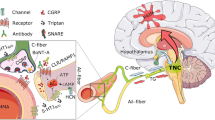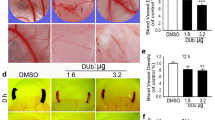Abstract
Vasoactive intestinal peptide (VIP) and pituitary adenylate cyclase-activating polypeptide (PACAP) are neuropeptides acting through VPAC1, VPAC2 and PAC1 receptors (referred here as the VIP-receptor system). In the central nervous system, VIP and PACAP are involved in neurogenesis, cell differentiation and migration, suggesting that they could be implicated in the development of glioblastoma (GBM). The infiltrative nature of GBM remains a major problem for the therapy of these tumors. We previously demonstrated that the VIP-receptor system regulated cell migration of the human cell lines M059J and M059K, derived from a single human GBM. Here, we evaluated the involvement of the VIP-receptor system in GBM cell invasion. In Matrigel invasion assays, M059K cells that express more the VIP-receptor system than M059J cells were less invasive. Invasion assays performed in the presence of agonists, antagonists or anti-PACAP antibodies as well as experiments with transfected M059J cells overexpressing the VPAC1 receptor indicated that the more the VIP-receptor system was expressed and activated, the less the cells were able to invade. Western immunoblotting experiments revealed that the VIP-receptor system inactivated the signaling protein AKT. Invasion assays carried out in the presence of an AKT inhibitor demonstrated the involvement of this signaling kinase in the regulation of cell invasion by the VIP-receptor system in M059K cells. The inhibition by VIP of invasion and AKT was also observed in U87 cells. In conclusion, VIP and PACAP act as anti-invasive factors in different GBM cell lines, a function mediated by VPAC1 inhibition of AKT signaling in M059K cells.





Similar content being viewed by others
References
Dunn GP, Rinne ML, Wykosky J et al (2012) Emerging insights into the molecular and cellular basis of glioblastoma. Genes Dev 26:756–784
Nakada M, Nakada S, Demuth T, Tran NL, Hoelzinger DB, Berens ME (2007) Molecular targets of glioma invasion. Cell Mol Life Sci CMLS 64:458–478
Dickson L, Finlayson K (2009) VPAC and PAC receptors: from ligands to function. Pharmacol Ther 121:294–316
Harmar AJ, Fahrenkrug J, Gozes I, Laburthe M, May V, Pisegna JR, Vaudry D, Vaudry H, Waschek JA, Said SI (2012) Pharmacology and functions of receptors for vasoactive intestinal peptide and pituitary adenylate cyclase-activating polypeptide: IUPHAR review 1. Br J Pharmacol 166:4–17
Robberecht P, Woussen-Colle MC, Vertongen P, De Neef P, Hou X, Salmon I, Brotchi J (1994) Expression of pituitary adenylate cyclase activating polypeptide (PACAP) receptors in human glial cell tumors. Peptides 15:661–665
Reubi JC (1995) In vitro identification of vasoactive intestinal peptide receptors in human tumors: implications for tumor imaging. J Nucl Med Off Publ Soc Nucl Med 36:1846–1853
Vertongen P, Camby I, Darro F, Kiss R, Robberecht P (1996) VIP and pituitary adenylate cyclase activating polypeptide (PACAP) have an antiproliferative effect on the T98G human glioblastoma cell line through interaction with VIP2 receptor. Neuropeptides 30:491–496
Jaworski DM (2000) Expression of pituitary adenylate cyclase-activating polypeptide (PACAP) and the PACAP-selective receptor in cultured rat astrocytes, human brain tumors, and in response to acute intracranial injury. Cell Tissue Res 300:219–230
Sharma A, Walters J, Gozes Y, Fridkin M, Brenneman D, Gozes I, Moody TW (2001) A vasoactive intestinal peptide antagonist inhibits the growth of glioblastoma cells. J Mol Neurosci MN 17:331–339
Dufes C, Alleaume C, Montoni A, Olivier J-C, Muller J-M (2003) Effects of the vasoactive intestinal peptide (VIP) and related peptides on glioblastoma cell growth in vitro. J Mol Neurosci MN 21:91–102
Cochaud S, Chevrier L, Meunier A-C, Brillet T, Chadéneau C, Muller J-M (2010) The vasoactive intestinal peptide-receptor system is involved in human glioblastoma cell migration. Neuropeptides 44:373–383
Masmoudi-Kouki O, Gandolfo P, Castel H, Leprince J, Fournier A, Dejda A, Vaudry H, Tonon M-C (2007) Role of PACAP and VIP in astroglial functions. Peptides 28:1753–1760
Cameron DB, Galas L, Jiang Y, Raoult E, Vaudry D, Komuro H (2007) Cerebellar cortical-layer-specific control of neuronal migration by pituitary adenylate cyclase-activating polypeptide. Neuroscience 146:697–712
Allalunis-Turner MJ, Barron GM, Day RS 3rd, Dobler KD, Mirzayans R (1993) Isolation of two cell lines from a human malignant glioma specimen differing in sensitivity to radiation and chemotherapeutic drugs. Radiat Res 134:349–354
Wang H, Wang H, Zhang W, Huang HJ, Liao WSL, Fuller GN (2004) Analysis of the activation status of Akt, NFkappaB, and Stat3 in human diffuse gliomas. Lab Investig J Tech Methods Pathol 84:941–951
Joy AM, Beaudry CE, Tran NL, Ponce FA, Holz DR, Demuth T, Berens ME (2003) Migrating glioma cells activate the PI3-K pathway and display decreased susceptibility to apoptosis. J Cell Sci 116:4409–4417
Kleber S, Sancho-Martinez I, Wiestler B et al (2008) Yes and PI3K bind CD95 to signal invasion of glioblastoma. Cancer Cell 13:235–248
Miao H, Li D-Q, Mukherjee A et al (2009) EphA2 mediates ligand-dependent inhibition and ligand-independent promotion of cell migration and invasion via a reciprocal regulatory loop with Akt. Cancer Cell 16:9–20
Kwiatkowska A, Kijewska M, Lipko M, Hibner U, Kaminska B (2011) Downregulation of Akt and FAK phosphorylation reduces invasion of glioblastoma cells by impairment of MT1-MMP shuttling to lamellipodia and downregulates MMPs expression. Biochim Biophys Acta 1813:655–667
Natsume A, Kato T, Kinjo S et al (2012) Girdin maintains the stemness of glioblastoma stem cells. Oncogene 31:2715–2724
Stambolic V, Woodgett JR (2006) Functional distinctions of protein kinase B/Akt isoforms defined by their influence on cell migration. Trends Cell Biol 16:461–466
Kwiatkowska A, Symons M (2013) Signaling determinants of glioma cell invasion. Adv Exp Med Biol 986:121–141
Qiao M, Sheng S, Pardee AB (2008) Metastasis and AKT activation. Cell Cycle Georget Tex 7:2991–2996
Koul D, Parthasarathy R, Shen R, Davies MA, Jasser SA, Chintala SK, Rao JS, Sun Y, Benvenisite EN, Liu TJ, Yung WK (2001) Suppression of matrix metalloproteinase-2 gene expression and invasion in human glioma cells by MMAC/PTEN. Oncogene 20:6669–6678
Takahashi S, Yamada-Okabe H, Hamada K, Ohta S, Kawase T, Yoshida K, Toda M (2011) Downregulation of uPARAP mediates cytoskeletal rearrangements and decreases invasion and migration properties in glioma cells. J Neurooncol 103:267–276
Balster DA, O’Dorisio MS, Albers AR, Park SK, Qualman SJ (2002) Suppression of tumorigenicity in neuroblastoma cells by upregulation of human vasoactive intestinal peptide receptor type 1. Regul Pept 109:155–165
May V, Lutz E, MacKenzie C, Schutz KC, Dozark K, Braas KM (2010) Pituitary adenylate cyclase-activating polypeptide (PACAP)/PAC1HOP1 receptor activation coordinates multiple neurotrophic signaling pathways: Akt activation through phosphatidylinositol 3-kinase gamma and vesicle endocytosis for neuronal survival. J Biol Chem 285:9749–9761
Mei FC, Qiao J, Tsygankova OM, Meinkoth JL, Quilliam LA, Cheng X (2002) Differential signaling of cyclic AMP: opposing effects of exchange protein directly activated by cyclic AMP and cAMP-dependent protein kinase on protein kinase B activation. J Biol Chem 277:11497–11504
Nijholt IM, Dolga AM, Ostroveanu A, Luiten PGM, Schmidt M, Eisel ULM (2008) Neuronal AKAP150 coordinates PKA and Epac-mediated PKB/Akt phosphorylation. Cell Signal 20:1715–1724
Higuchi M, Masuyama N, Fukui Y, Suzuki A, Gotoh Y (2001) Akt mediates Rac/Cdc42-regulated cell motility in growth factor-stimulated cells and in invasive PTEN knockout cells. Curr Biol CB 11:1958–1962
Fernández-Martínez AB, Bajo AM, Sánchez-Chapado M, Prieto JC, Carmena MJ (2009) Vasoactive intestinal peptide behaves as a pro-metastatic factor in human prostate cancer cells. Prostate 69:774–786
Fernández-Martínez AB, Bajo AM, Isabel Arenas M, Sánchez-Chapado M, Prieto JC, Carmena MJ (2010) Vasoactive intestinal peptide (VIP) induces malignant transformation of the human prostate epithelial cell line RWPE-1. Cancer Lett 299:11–21
Ogasawara M, Murata J, Ayukawa K, Saiki I (1997) Differential effect of intestinal neuropeptides on invasion and migration of colon carcinoma cells in vitro. Cancer Lett 119:125–130
Vacas E, Arenas MI, Muñoz-Moreno L, Bajo AM, Sánchez-Chapado M, Prieto JC, Carmena MJ (2013) Antitumoral effects of vasoactive intestinal peptide in human renal cell carcinoma xenografts in athymic nude mice. Cancer Lett 336:196–203
Hoyer D, Bartfai T (2012) Neuropeptides and neuropeptide receptors: drug targets, and peptide and non-peptide ligands: a tribute to Prof Dieter Seebach. Chem Biodivers 9:2367–2387
Acknowledgments
We thank Marianne Bernard for her help in the preparation of plasmid stocks in bacteria and Pr L. Karayan, Université de Poitiers, who kindly provided the M059J and M059K cells. This work was supported by grants from the ‘‘Institut National du Cancer (INCA), Cancéropôle Grand-Ouest”, from the ‘‘Ligue contre le Cancer du Grand-Ouest, comité de la Vienne et comité des Deux-Sèvres” and from the “Lions Club de Melle”. Stéphanie Cochaud and Souheyla Bensalma were recipients of Ph.D. fellowships from the French ‘‘Ministère de l’enseignement supérieur et de la recherche” and from the « Région Poitou–Charentes», respectively.
Conflict of interest
The authors declare that they have no conflict of interest.
Author information
Authors and Affiliations
Corresponding author
Rights and permissions
About this article
Cite this article
Cochaud, S., Meunier, AC., Monvoisin, A. et al. Neuropeptides of the VIP family inhibit glioblastoma cell invasion. J Neurooncol 122, 63–73 (2015). https://doi.org/10.1007/s11060-014-1697-6
Received:
Accepted:
Published:
Issue Date:
DOI: https://doi.org/10.1007/s11060-014-1697-6




